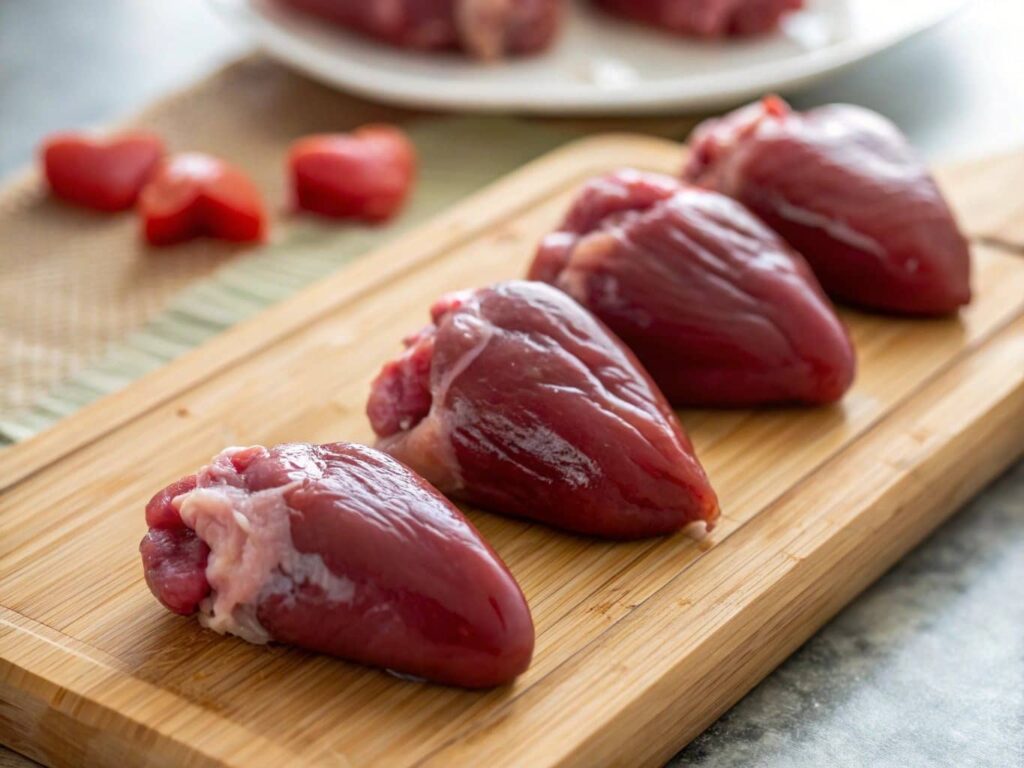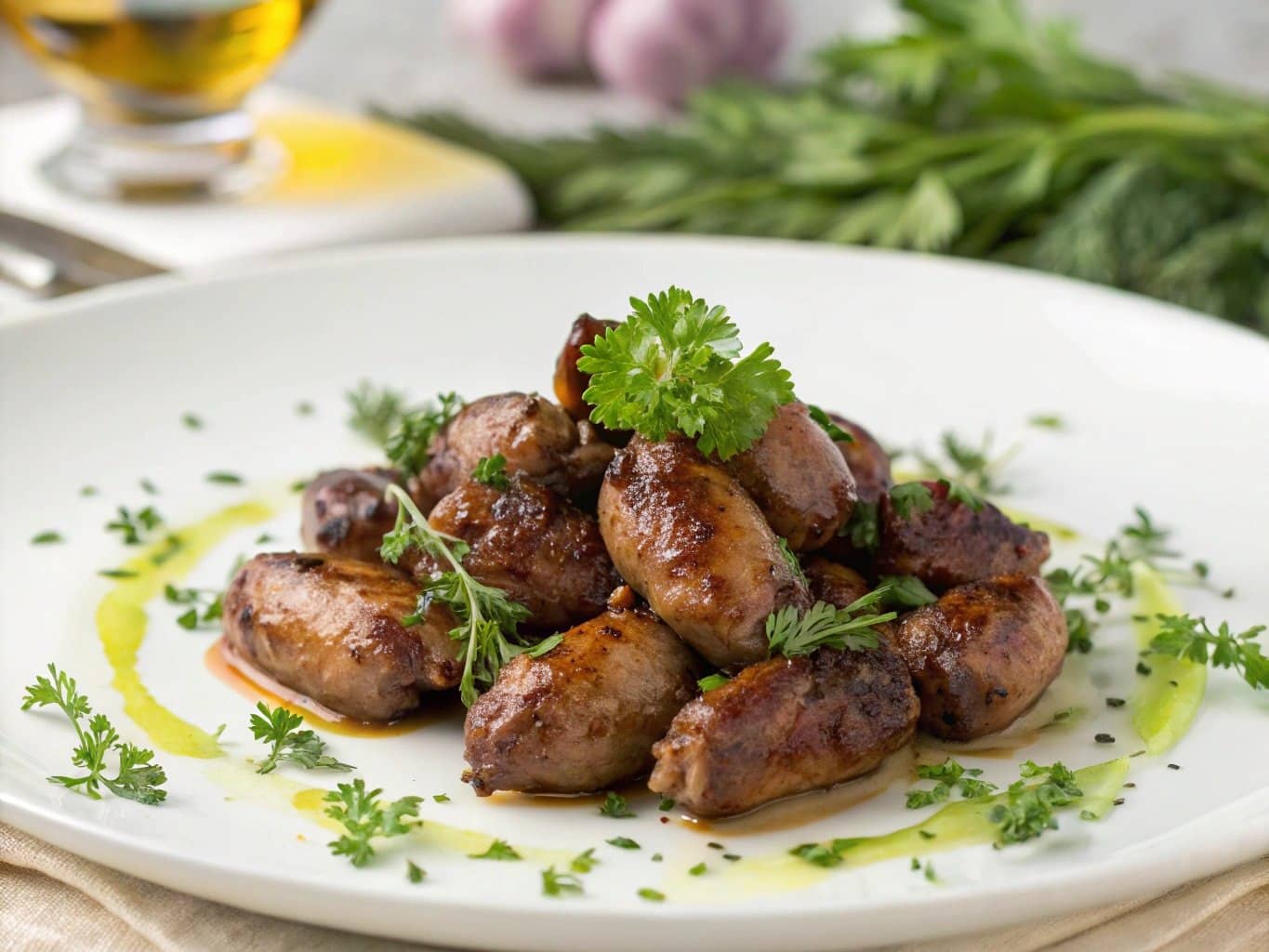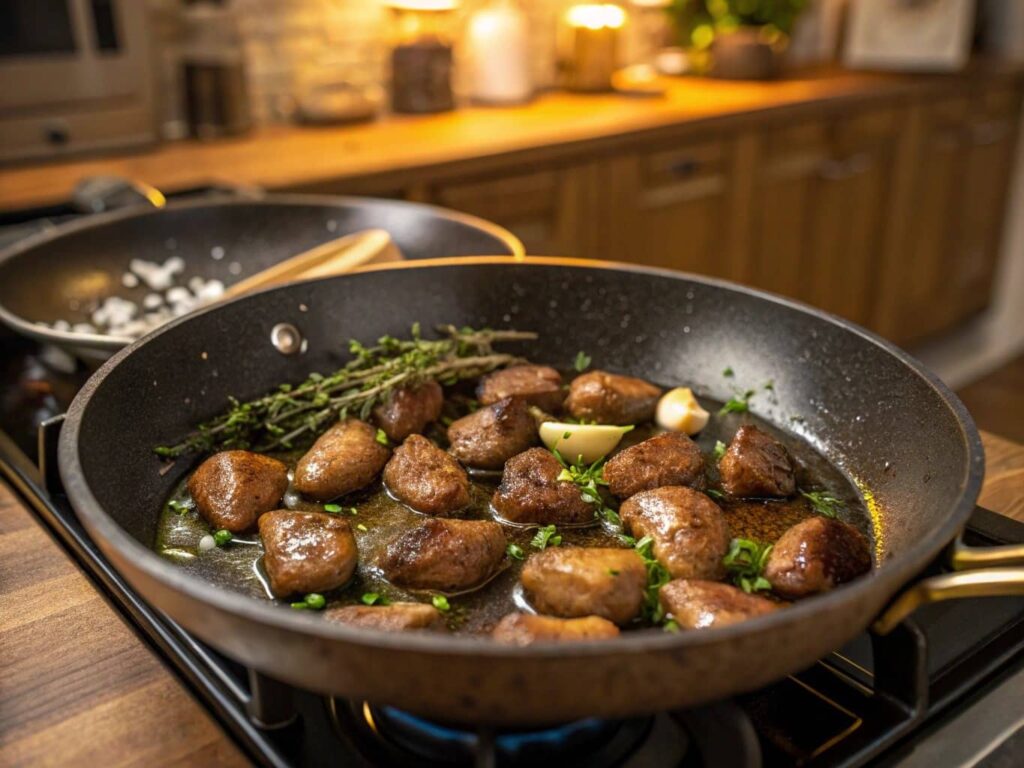If you’re wondering whether chicken hearts need to be cleaned before cooking them, you’re not alone! This is a common question, as chicken hearts are both flavorful and nutritious, making them a great addition to various dishes.
Chicken hearts are a nutritious, flavorful, and often overlooked part of the chicken. But just like any part of the chicken, they need to be cleaned properly to ensure they are safe to eat and taste great. In this article, we will guide you through everything you need to know about cleaning chicken hearts, including why it’s important, how to do it, and tips for preparing them perfectly.
Do chicken hearts need to be cleaned?
Table of contents
Why Cleaning Chicken Hearts Is Important
When it comes to cooking, the first thing we think about is taste. But cleaning is just as important! Chicken hearts, like other organ meats, can have a lot of unwanted bits like fat, membranes, and even leftover blood vessels. If you skip cleaning, you might end up with a tough, greasy texture, or worse, a dish that doesn’t taste quite right.
Cleaning chicken hearts helps remove these unwanted parts and ensures that you’re left with the tender, flavorful meat that’s great for grilling, stir-frying, or even making a savory stew. But don’t worry—it’s not as difficult as it sounds. With a few simple steps, you’ll be able to clean chicken hearts like a pro!
What Are Chicken Hearts?
Before we dive into cleaning, let’s take a moment to talk about what chicken hearts actually are. A chicken heart is an organ meat, just like liver or kidneys. The heart is a small, muscle-packed organ that helps pump blood throughout the chicken’s body. Because it’s muscle, chicken hearts are rich in protein and nutrients, making them a popular choice for people who want to add variety to their meals.
Chicken hearts are often sold in small packages, either fresh or frozen, and can be found in most grocery stores or local butcher shops. They are typically very affordable, which is why they’ve become a favorite ingredient in many cuisines around the world, especially in countries where organ meats are more commonly used in cooking.

Nutritional Value of Chicken Hearts
Chicken hearts are not only tasty, but they’re also packed with nutrients that are great for your health! Here’s a breakdown of the main nutritional benefits:
| Nutrient | Amount (per 100g) |
|---|---|
| Calories | 155 kcal |
| Protein | 26g |
| Fat | 6g |
| Iron | 6mg |
| Vitamin B12 | 3.5µg |
As you can see, chicken hearts are packed with protein and low in fat, making them a healthy option for many types of dishes. They also contain a good amount of iron, which is essential for producing red blood cells and keeping energy levels up. Plus, the vitamin B12 in chicken hearts helps keep your nervous system healthy!
The Cleaning Process: A Step-by-Step Guide
Now that you know what chicken hearts are and why they’re worth cleaning, let’s get into the step-by-step process for cleaning them properly. Don’t worry, it’s easy! With just a few tools and some patience, you’ll have your chicken hearts cleaned and ready to cook in no time.
Preparing the Chicken Hearts for Cleaning
Before you start cleaning, make sure you have everything you need. Grab the following items:
- A cutting board
- A sharp knife
- A bowl of cold water
- Paper towels
Once you have everything set up, it’s time to prepare the chicken hearts for cleaning. If they’re frozen, make sure to thaw them completely in the refrigerator. Once thawed, rinse the chicken hearts under cold water to remove any ice crystals and to give them a quick clean.
Removing the Fat and Membranes
Now comes the slightly trickier part: removing any fat and membranes. Chicken hearts often come with a thin layer of fat and connective tissue attached to them. It’s essential to remove these parts because they can make the hearts chewy and greasy when cooked.
To remove the fat, use your knife to gently slice away the excess fat from the heart. You don’t need to be too aggressive—just trim off the visible fatty bits. Be careful not to cut too deep into the muscle of the heart, as you want to keep as much of the tender meat as possible.
Next, you’ll want to remove any membrane or connective tissue. This can be a little tricky, but it’s important. Just use the tip of your knife to gently peel away the membrane. It should come off fairly easily, but if you’re having trouble, use a paper towel to grip it and pull it off. If you’re still having trouble, it’s okay to leave a tiny bit of membrane behind. It won’t ruin the taste or texture.
Rinsing and Washing Chicken Hearts
After you’ve removed the fat and membranes, rinse the chicken hearts again under cold water. This will help get rid of any leftover bits of fat or tissue. Give them a quick rub between your fingers to make sure they’re thoroughly clean.
Once clean, pat the hearts dry with a paper towel. This is especially important if you’re planning to grill or sauté them, as excess moisture can cause them to steam rather than cook properly. Dry chicken hearts will cook more evenly and develop a delicious, crispy outer layer when seared.

“Cleaning chicken hearts may seem like an extra step, but it’s totally worth it! You’ll end up with a much tastier, smoother texture in your final dish.”
Why Some People Choose to Clean Chicken Hearts
Now that you know how to clean chicken hearts, you might be wondering: why is this necessary? Can’t you just cook them as is? While it’s technically possible to cook chicken hearts without cleaning them, many people choose to clean them for a few important reasons:
Health Concerns and Hygiene
Cleaning the chicken hearts helps ensure that any residual blood, fat, or bacteria is removed before cooking. Chicken hearts are an organ meat, which means they can sometimes harbor bacteria if they’re not handled properly. Cleaning them thoroughly helps reduce any potential risks, making them safer to eat.
Enhancing Taste and Texture
As mentioned earlier, chicken hearts can have a tough texture if they aren’t cleaned properly. Removing the fat and membrane allows the hearts to cook more evenly, resulting in a tender, juicy bite. It also helps remove any unwanted flavors that might be lingering in the fat and tissue, leaving only the rich, savory taste of the heart.
Common Problems When Cleaning Chicken Hearts
Even with a straightforward cleaning process, some people encounter issues along the way. Don’t worry if things don’t go perfectly—these problems are common and easy to fix!
Incomplete Cleaning Leading to Tough Texture
One of the most common problems when cleaning chicken hearts is not removing all the fat and membrane. If you leave too much behind, it can cause the hearts to be chewy or greasy when cooked. If you notice that your chicken hearts are tough after cooking, it’s likely that the cleaning process wasn’t thorough enough.
Difficulty in Removing the Fat and Membranes
Sometimes, the fat and membranes can be tough to remove. If you’re having trouble, try using a paper towel to help you grip the fat or membrane. Alternatively, you can ask your butcher to do the cleaning for you before buying the chicken hearts.
And don’t forget—if you miss a little bit of fat or membrane, it’s not the end of the world. Just make sure to cook the hearts at a high temperature so that any remaining fat melts away, leaving the tender meat behind.
Do You Really Need to Clean Chicken Hearts?
At this point, you might be thinking: “Okay, but do chicken hearts *really* need to be cleaned? Is it absolutely necessary?” The short answer is yes, but let’s break it down a bit more to understand why some people skip this step and what you’re missing if you don’t clean them.
Differences Between Pre-Packaged and Fresh Chicken Hearts
When it comes to chicken hearts, there are two main types you might encounter: pre-packaged (often frozen) and fresh ones. Pre-packaged chicken hearts are often cleaned to some extent, but they can still have residual fat or membranes that might not have been fully removed. These packages might also have some blood left inside, which could affect the flavor and texture.
On the other hand, fresh chicken hearts, especially if you buy them from a butcher, usually need a more thorough cleaning. While they might not have any added preservatives or chemicals, they tend to have more fat and membranes that need to be removed for optimal taste and texture.
Pros and Cons of Cleaning Chicken Hearts
Let’s weigh the pros and cons of cleaning chicken hearts to help you make an informed decision:
- Pros:
- Improved taste and texture.
- Reduced fat and greasy texture.
- Safer to eat, as you eliminate any bacteria or contaminants.
- Cons:
- It’s a little time-consuming.
- If not cleaned carefully, some parts might be tough to remove.
While cleaning chicken hearts does require a little effort, the benefits far outweigh the cons. If you want your chicken hearts to taste the best they can, cleaning is the way to go. But if you’re short on time and don’t mind a bit of extra fat, you can skip it, just be aware of the potential impact on the final dish.
Alternative Methods for Preparing Chicken Hearts
Maybe you’re not convinced about cleaning chicken hearts, and that’s okay! There are other ways to prepare them that still result in delicious dishes. If you prefer not to clean the hearts or don’t have the time, here are a few alternative methods for preparing chicken hearts:
Using Chicken Hearts for Broths or Soups
One of the easiest ways to prepare chicken hearts without cleaning them is by using them in broths or soups. The long cooking time in a simmering broth helps break down the fat and membranes, making the hearts tender and flavorful without needing to do much work beforehand. Plus, the broth picks up all the savory flavors of the chicken hearts, creating a rich, hearty soup that’s packed with nutrients!
Just toss the chicken hearts into your pot of simmering vegetables and bones, and let them cook for hours. Once they’re soft and tender, you can remove them from the broth, and they’ll be ready to eat. If you prefer, you can also blend them into the soup for an extra creamy texture.
Cooking Chicken Hearts Without Cleaning
If you’re feeling adventurous and don’t mind the extra fat and texture, you can cook chicken hearts without cleaning them at all. The fat and membranes might cause the hearts to be a bit chewier or greasier, but some people actually prefer this natural, unaltered approach. You can grill or sauté them as they are, just be sure to cook them thoroughly to ensure food safety.
Although cooking chicken hearts without cleaning them can result in a different texture, they still taste great when paired with the right seasonings or cooked in a marinade. Just make sure you’re comfortable with the additional fat and the possibility of a slightly tougher bite.
Tips for Cooking Chicken Hearts After Cleaning
Once you’ve cleaned your chicken hearts, the next step is cooking them! Here are some tips to help you cook them to perfection:
Recommended Cooking Methods (Grilled, Sautéed, etc.)
Chicken hearts are incredibly versatile, and there are several methods you can use to cook them. Here are some of the most popular cooking techniques:
- Grilled: Grilling chicken hearts is a great way to bring out their natural flavors. Skewer the cleaned hearts and cook them over medium heat for 3-5 minutes per side, depending on your preference for doneness.
- Sautéed: Heat some oil in a pan over medium heat, add the cleaned chicken hearts, and cook them for 6-8 minutes, turning occasionally. You can season them with garlic, onion, or spices for added flavor.
- Stir-fried: Chicken hearts also work well in stir-fries. Just toss them into a hot wok with vegetables and soy sauce for a quick and tasty meal.
- In stews: Chicken hearts can add a lot of flavor to stews and soups. Simply toss them in at the beginning and let them simmer until tender.
Flavor Pairings That Work Well with Chicken Hearts

If you want to elevate the flavor of your chicken hearts, here are some ingredients that pair perfectly with them:
- Garlic and onions
- Spices like paprika, cumin, or chili powder
- Herbs like thyme, rosemary, or parsley
- Sauces such as soy sauce, balsamic vinegar, or lemon juice
- Vegetables like bell peppers, mushrooms, or spinach
These ingredients can be added while cooking or used as a garnish to bring out the natural richness of the chicken hearts. Whether you’re grilling, sautéing, or making a stew, these flavors will take your dish to the next level!
Frequently Asked Questions About Do chicken hearts need to be cleaned
Can You Eat Chicken Hearts Without Cleaning Them?
Yes, you can technically eat chicken hearts without cleaning them, but it’s not the best choice for most people. The fat, membranes, and residual blood vessels can make the texture tough and greasy. Cleaning them improves the taste and makes them more enjoyable to eat. But if you’re in a rush or prefer a more rustic approach, cooking them without cleaning will still give you a tasty result—just expect a different texture.
How Can You Tell If Chicken Hearts Are Cleaned Properly?
When chicken hearts are cleaned properly, they should be free of any visible fat, membranes, and other unwanted tissue. The hearts should look smooth and clean, with a nice, vibrant color. If you run your fingers over them, they should feel firm, not slippery or greasy. If the hearts are still oily or have tough, chewy parts, they likely need a bit more cleaning.
So, Do Chicken Hearts Need to Be Cleaned?
In conclusion, yes, chicken hearts should be cleaned before cooking to ensure they are safe to eat, taste great, and have the right texture. The cleaning process may seem a little intimidating at first, but it’s straightforward and totally worth it for the flavor and tenderness it brings to your dish. Whether you’re grilling, sautéing, or making a hearty stew, clean chicken hearts will always result in a delicious meal. But if you’re short on time or prefer a more rustic preparation, you can cook them without cleaning. Just keep in mind that the texture might not be as tender, and the flavor might be a little different.
So, the next time you buy chicken hearts, don’t skip the cleaning step! You’ll end up with a healthier, tastier, and more enjoyable meal. Happy cooking! 🍴🐔
Explore More About Chicken Hearts and Cooking Tips
If you found this article helpful, you might also enjoy learning about the many health benefits of chicken hearts and some easy recipes to try. Check out our article on Chicken Hearts: Health Benefits and Easy Recipes You’ll Love for more delicious ways to incorporate chicken hearts into your meals!
Curious about the flavor of chicken hearts? You might want to read our guide on What Does a Chicken Heart Taste Like? to get a better idea of how this unique ingredient can enhance your cooking!






